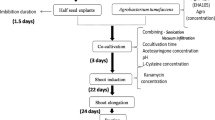Abstract
Lysine rich protein (LRP) gene derived from the seed of Psophocarpus tetragonolobus was transformed into Brassica napus, employing cotyledon petiole as explants and by using the Agrobacterium tumefaciens strain LBA4404. Transformation efficiency was found to be closely related with phytohormone concentration, infection incubation, and co-cultured time. A medium containing 4 mg/l 6-benzyladenine (6-BA) and 0.3 mg/1 naphthalene acetic acid (NAA) was used for plant regeneration. With infection incubation of A. tumefaciens (OD600 = 0.4) for 20 min and co-culture of infected cotyledon petiole for 3 days, the highest transformation efficiency of 8.5% was obtained. To confirm LRP gene expression, PCR and Southern blot analysis were performed on leaf-isolated DNA from regenerated plants resistant to kanamycin. All transgenic plants of the generation T0 formed fertile seeds, which were sowed for the inheritance study of generational T1 and amino acid analysis. It was found that the lysine content of seeds from T1 generation increased by 16.7% compared with non-transgenic lines.
Similar content being viewed by others
References
Bell, J.M., Nutrients and Toxicant in Rapeseed Meal: A Review, J. Anim. Sci., 1984, vol. 58, pp. 996–1010.
Pastuszewska, B., Jablecki, G., Swiech, E., et al., Nutritional Value of Rapeseed Meal Containing Lecithin Gums Precipitated with Citric Acid, Anim. Feed Sci. Technol., 2000, vol. 86, pp. 117–123.
Hejgaard, J. and Boisen, S., High-Lysine Proteins in Hiproly Barley Breeding: Identification, Nutritional Significance and New Screening Methods, Hereditas, 1980, vol. 93, pp. 311–320.
Kumamaru, T., Sato, H., and Satoh, H., High-Lysine Mutants of Rice, Oryza sativa L., Plant Breed., 1997, vol. 116, pp. 245–249.
Sun, S.S.M. and Liu, Q.Q., Transgenic Approaches to Improve the Nutritional Quality of Plant Protein, In Vitro Cell. Dev. Biol.-Plan., 2004, vol. 40, pp. 155–162.
Lang, Z.H., Yu, J.J., Zhu, D.Y., et al., Cloning of a Lysine-Rich Gene SBgLR and the Effect of Improving the Protein and Lysine Content in Transgenic Maize Seed, J. Agric. Biotech., 2004, vol. 12, pp. 487–492.
Meng, C., Chen, X., Liang, R., et al., Expression of Lysine-Rich Protein Gene and Analysis of Lysine Content in Transgenic Wheat, Chin. Sci. Bull., 2004, vol. 49, pp. 2053–2057.
Qi, D., Zou, L., Li, P., et al., Introduction of Lysine-Rich Protein Gene sb401 into Rice by Agrobacterium tumefaciens-Mediated Method, Mol. Plant Breed., 2005, vol. 3, pp. 195–202.
Yu, J., Peng, P., Zhang, X., et al., Seed-Specific Expression of the Lysine-Rich Protein Gene sb401 Significantly Increase Both Lysine and Total Content in Maize Seeds, Food Nutr. Bull., 2005, vol. 26, pp. 427–431.
Huang, S., Frizzi, A., Florida, C.A., et al., High Lysine and High Tryptophan Transgenic Maize Resulting from the Reduction of Both 19- and 22-kD [α]-Zeins, Plant Mol. Biol., 2006, vol. 61, pp. 525–535.
Li, X., Li, X., Zhang, J., et al., Expression and Inheritance of Lysine-Rich Protein Gene in Lettuce (Lactuca sativa L.), Chin. J. Appl. Environ. Biol., 2006, vol. 12, pp. 472–475.
Bicar, E.H., Woodman-Clikeman, W., Sangtong, V., et al., Transgenic Maize Endosperm Containing a Milk Protein Has Improved Amino Acid Balance, Trans. Res., 2008, vol. 17, pp. 59–71.
Shaul, O. and Galili, G., Increased Lysine Biosynthesis in Tobacco Plants That Express High Levels of Bacterial Dihydrodipicolinate Synthase in Their Chloroplasts, Plant J., 1992, vol. 11, pp. 203–209.
Brinch-Pedersen, H., Galili, G., Knuden, S., and Holm, P.B., Engineering of the Aspartate Family Biosynthetic Pathway in Barley (Hordeum vulgare L.) by Transformation with Heterologous Genes Encoding Feed-Back-Insensitive Aspartate Kinase and Dihydrodipicolinate Synthase, Plant Mol. Biol., 1996, vol. 32, pp. 611–620.
Sun, S.S.M., Xing, L.W., and Jing, X.Y., Lysine Rich Protein from Winged Bean, US Patent Application 08/964722, 1998.
Zhang, X.J., Liu, J.Q., Zhao, Q., et al., Transfer of High Lysine-Rich Gene into Maize by Microprojectile Bombardment and Detection of Transgenic Plants, J. Agric. Biotech., 1999, vol. 7, pp. 363–367.
Sun, X.H., Ao, G.M., Yu, J.J., and Zhao, Q., Transfer of High Lysine-Rich Gene into Maize Inbred Lines and the Detection of Transgenic Plants, J. Agric. Biotech., 2001, vol. 9, pp. 156–158.
Gao, Y.F., Jing, Y.X., Shen, S.H., et al., Transfer of Lysine-Rich Protein Gene into Rice and Production of Fertile Transgenic Plants, Acta Bot. Sinica, 2001, vol. 43, pp. 506–511.
Wang, Y.P., Sonntag, K., Rudloff, E., and Han, J., Production of Fertile Transgenic Brassica napus by Agrobacterium-Mediated Transformation of Protoplasts, Plant Breed., 2005, vol. 124, pp. 1–4.
Offringa, R. and van der Lee, F., Isolation and Characterization of Plant Genomic DNA Sequences via Inverse PCR Amplification, Method Mol. Biol., 1996, vol. 49, pp. 1064–3745.
Lv, C.X., Li, T.W., and Su, X.R., Analysis of Amino Acid in Five Edible Marine Animals, J. Ningbo Univ. (NSEE), 2007, vol. 20, pp. 315–319.
Maenz, D.D., Newkirk, R.W., Classen, H.L., et al., The Nutritional Value of Rapeseed Protein Concentrate (MCN BioProducts Inc.-CanPro-IP65) for Rainbow Trout, in Proceedings of 11th International Rapeseed Congress, Copenhagen, 2003, pp. 1234–1236.
Bhinu, V.S., Schaefer, U.A, Li, R., et al., Target Modulation of Sinapine Biosynthesis Pathway for Seed Quality Improvement in Brassica napus, Trans. Res., 2009, vol. 18, pp. 31–44.
Slominski, B.A., Simbaya, J., Campbell, J.D., et al., Nutritive Value for Broilers of Meals Derived from Newly Developed Varieties of Yellow-Seeded Canola, Anim. Feed Sci. Technol., 1999, vol. 78, pp. 249–262.
Tang, L., Liu, Q.Q., Deng, X.X., et al., LRP Transgenic Indica Rice Restorer Line without Resistance Selection Marker, Acta Agric. Sinica, 2006, vol. 32, pp. 1248–1251.
Author information
Authors and Affiliations
Corresponding author
Additional information
The article is published in the original.
Rights and permissions
About this article
Cite this article
Wang, J., Chen, L., Liu, Q.Q. et al. Transformation of LRP gene into Brassica napus mediated by agrobacterium tumefaciens to enhance lysine content in seeds. Russ J Genet 47, 1433–1437 (2011). https://doi.org/10.1134/S1022795411120167
Received:
Published:
Issue Date:
DOI: https://doi.org/10.1134/S1022795411120167




